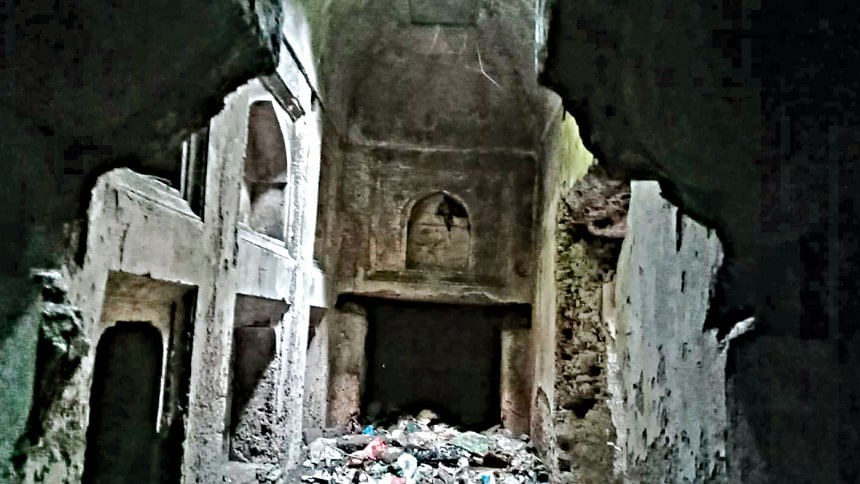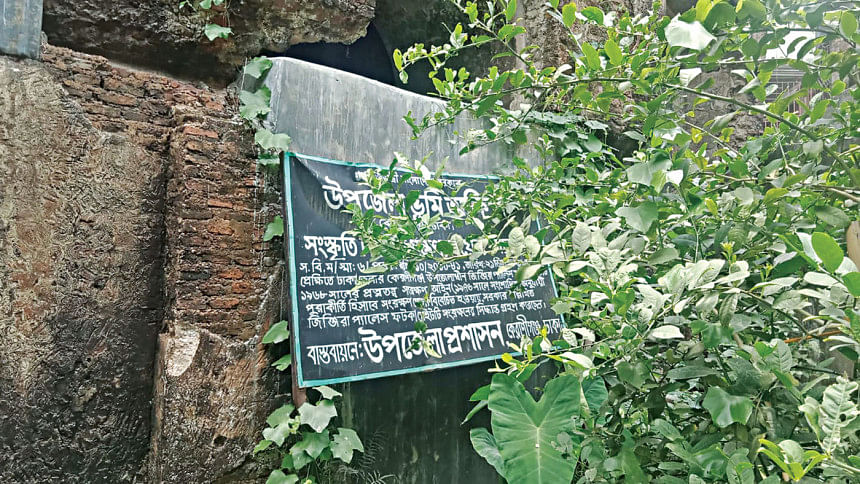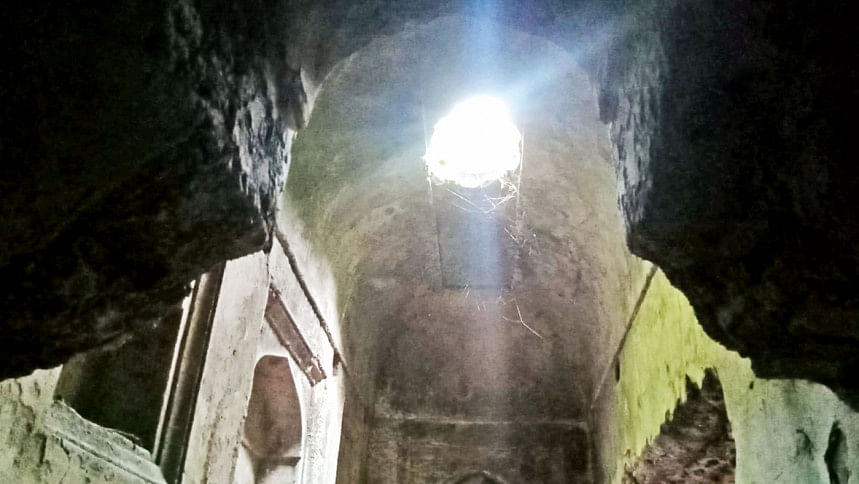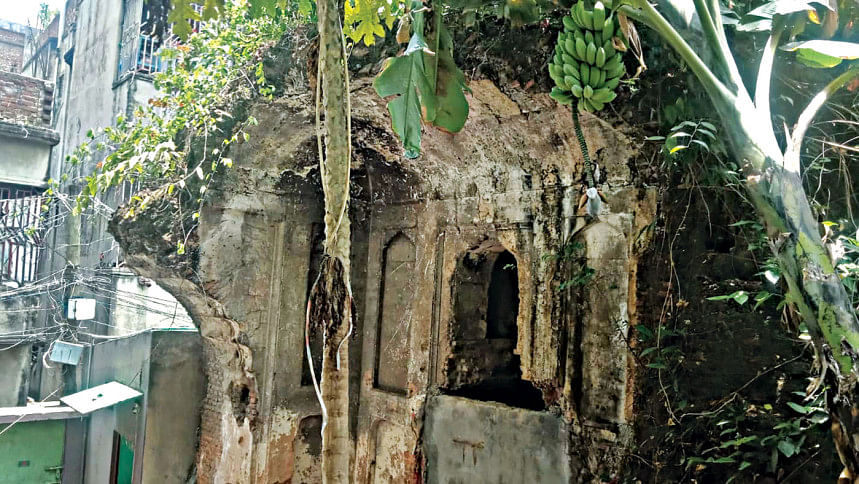Jinjira Palace a tale of treachery and negligence

Its history is intertwined with melancholy and treachery.
After the fall of Sirajuddaula, the last independent nawab of Bengal, his grandmother Sharifunnessa (Alivardi's wife), aunts Ghaseti Begum and Amina Begum, wife Lutfunnisa Begum and her daughter Qudsia Begum alias Umme Zohra were sent to Jinjira palace, where they were kept under close watch.
It is said that one Jamadar Bakr Khan put Ghaseti and Amina on a barge, on the pretext of taking them to safety in Murshidabad, and drowned them in a river in June 1760, under instructions of Mir Sadeq Ali Khan (Miran), son of Nawab Mir Jafar Ali Khan.
Mentionable, along with Mir Jafar and Miran, Ghaseti was also a part of the conspiracy against his nephew. But the two eventually betrayed her.
According to historians, Mughal Subedar Ibrahim Khan II (1689-1697) built Jinjira palace to be his recreation resort. The palace used to be surrounded by rivers and had the natural characteristics of an island.

It was hence named "Qasr-i-Jazirah", meaning palace of the island.
The structure, having originally been built just on the riverbank in Keraniganj, is said to have been connected to Dhaka by a wooden bridge thrown across the river at Bara Katra point.
However, Jinjira palace, which has played an important role in the history of Bengal, lies neglected and forgotten at present.
Accroding to Banglapedia, Jinjira Palace consisted of the palace edifice, two-storey rectangular extensive hammam (bathhouse) complex, the two-storey gateway with provision for guard rooms and two octagonal side towers on the south.
The rooms of the palace were rectangular with plastered walls and a vaulted roof.
However, it's impossible for a visitor to locate it without the help of a local.
It is mostly occupied by the area's residents. Locals call the place "hawli". The word originated from the Persian word "haveli", a generic term used for mansion.
The palace's view is now blocked by walls and newly built houses.

Only some parts of the palace remain -- one near the BNP office surrounded by new buildings, some old structures that are encroached and dilapidated, and another located near Pir Mohammad Pilot High School.
Two upazila administration signboards hang at the sites, while its illegal occupants have started to claim ownership.
During a recent visit, this correspondent talked to Mohammad Alamgir (67), a local who has been living in the area since his childhood.
"We've heard from our elders that when the British government was there, the governing body of the palace sold the site to different people," said Alamgir.
"When we were young, we could get the whole view of Dhaka from the palace-top."
"Since the 1970s, new buildings have been constructed here, and the palace started to disappear around the 1990s," claimed Alamgir.
Alamgir, however, claims the area to be "people's property". "But if the government instructs, we're bound to leave the place," he said.

"At least 200 buildings have already been constructed over the years, and if the residents are evicted, the question arises -- where will they go?" he added.
Golam Azam, owner of the adjoining land of one of the two remaining structures, said they've been living there since 1892. His grandfather, Haji Ojiullah, purchased the land when it was empty.
The traces of the remaining structure of the palace can be found amidst the newly built buildings, he said.
Golam added that the small rooms in that part of the palace are in a dilapidated condition. No one lives there.
When asked, State Minister for Power, Energy and Mineral Resources Nasrul Hamid said the entire area was under Jinjira palace, but it has been occupied by encroachers.
Hamid, also Dhaka-3 (Keraniganj) lawmaker, said he had submitted a demi official (DO) letter to the cultural ministry to take over the property for preservation. They've only put up a signboard there so far.
They didn't take any initiative to identify the property of the nawab by going through the records, nor have they taken any measures to evict the encroachers, he added.
Illegal occupants even used the palace's bricks to build their own houses, said the state minister.
A collective effort by relevant authorities, including Dhaka deputy commissioner and the cultural ministry, is needed to restore the palace, Hamid said.
Ratan Chandra Pandit, director general of Department of Archaeology, said most of the land by now is hawli residents' recorded property, which is a big problem.
"With local and administrative support, an intervention is required to restore it, but the matter is very complex. Local lawmakers can play the leading role in this regard," he said.
"We'll provide all our support if the initiative is taken collectively, but locals do not want to leave the area and even create obstacles to enter the place," Pandit said.
Keraniganj UNO Md Mehedi Hasan said they've issued a letter to the Department of Archaeology to take necessary steps to protect the site.
"We didn't get any response so far, although we had issued the letter around two years back," he said. "Dhaka district administration is aware of this, and we're working following their direction."
"We will first go through the records and figure out the situation of ownership. Then we will take action against the occupiers," Hasan said.
The palace can be a tourism spot, and public representatives are very sincere about the issue, he assured.
w

 For all latest news, follow The Daily Star's Google News channel.
For all latest news, follow The Daily Star's Google News channel. 



Comments